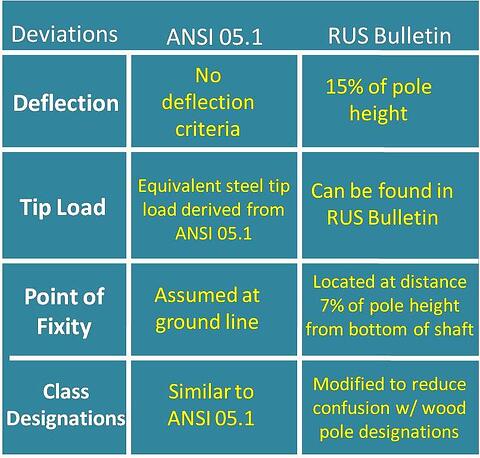Previously called Wood Pole Equivalents, Pre-Engineered Steel Poles are classified by the ground line moment that they can withstand. Using pre-engineered steel poles can be a practical way to minimize cost and time on certain projects. Generally, pre-engineered steel poles are used for distribution type projects rather than transmission lines due to the shorter spans and lower tensions used on distribution lines.
Pre-engineered steel pole design and classification follow a similar philosophy to that found in ANSI 05.1-2002 for wood poles. Per ANSI O5.1-2002, wood pole classifications can be determined by placing a horizontal tip load two feet from the top of the structure and determining the corresponding ground line moment. Pre-engineered steel poles are similarly designed and classified by applying an equivalent horizontal tip load two feet from the top of the structure. The equivalent horizontal tip load is found by multiplying the horizontal tip load found in ANSI 05.1-2002 by the ratio of factors of safety of steel to wood.
Many manufacturers have developed Pre-Engineered Steel Pole Catalogs for line designers to utilize when designing structures. These catalogs normally include structural characteristics, weights and maximum ground line moments. Most Pre-Engineered Steel Pole Catalogs take into account some industry wide assumptions as follows:
- Embedment depth is taken as 10% of the height plus two feet.
- Heights for pre-engineered steel pole catalogs range from 45-120 ft.
- Catalogs include Class 3 thru H10. Noting that Classes 1 thru 3 are typically not economical to fabricate using steel unless a round section can be utilized.
- Typically the same top diameter and taper are used per class.
- No deflection criterion is used.
Using pre-engineered steel poles may be a good option for a project if the owner and/or line designer is confident with the approximate ground line moment calculation on simple line designs or if the line designer is plugging in the structural properties of a pre-engineered steel pole from a catalog into a line design software. Using pre-engineered steel poles can help give a good idea of the pole sizes the owner and/or line designer will need. This method of design is generally used for single pole structures that are subject to transverse and vertical loads. Engineering judgment must be carefully exercised when using pre-engineered steel poles in applications that can cause forces to be redistributed along the pole length. Also to keep in mind, the owner and/or line designer is typically responsible for determining the applicable loads and loading criteria, geometric configuration, type and degree of structural support, as well as any other required design or performance characteristics for pre-engineered steel poles.
One requirement to look for when considering using pre-engineered steel poles for a project is adherence to the Rural Utilities Service (RUS) Bulletin 1724E-214. If a project is required to adhere to the RUS Bulletin, there may be some deviations from the standard pre-engineered pole industry standards/catalogs to consider. Some of the deviations include the following:
- Point of Fixity
- Tip Load
- Class Designations
- Deflection
The table below summarizes some of the differences that may be found between the RUS Bulletin and most Standard Pre-Engineered Steel Pole Catalogs.

*Class Designations may vary depending on manufacturer.
Using pre-engineered steel poles in line design can be an effective way to minimize cost and time associated with a project. It’s important to note that there may be deviations between a standard Pre-Engineered Steel Pole Catalog and the requirements of certain specifications, and it is ultimately the line designer’s responsibility to review all applicable specifications, pole configurations and loadings to ensure that a pre-engineered steel pole is the right choice for a structure.
*Content provided by Callie Lohman, PE, Civil Engineer at DIS-TRAN Steel, LLC.

